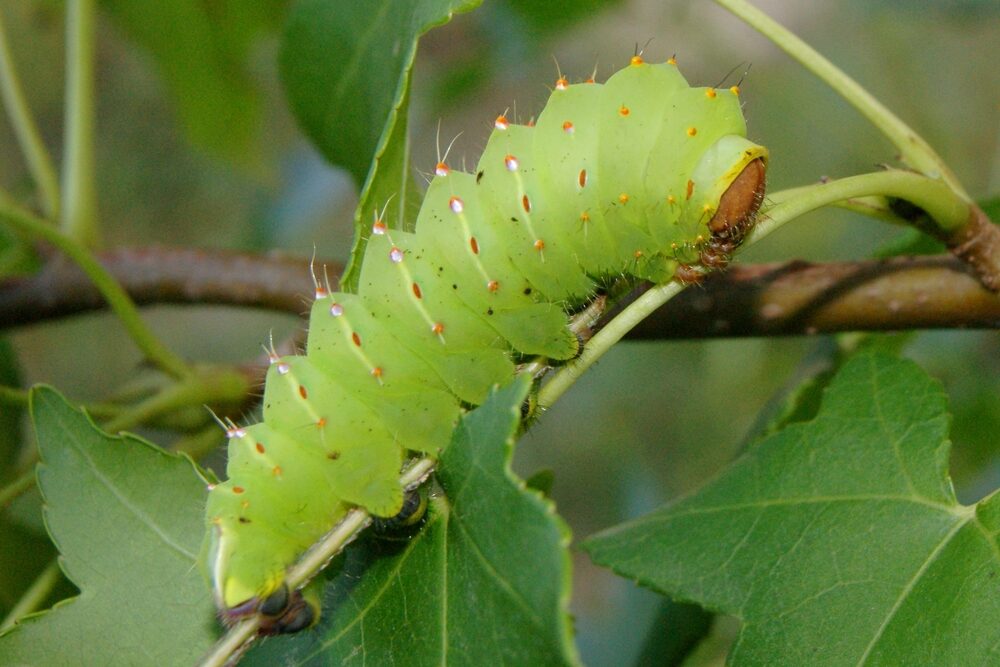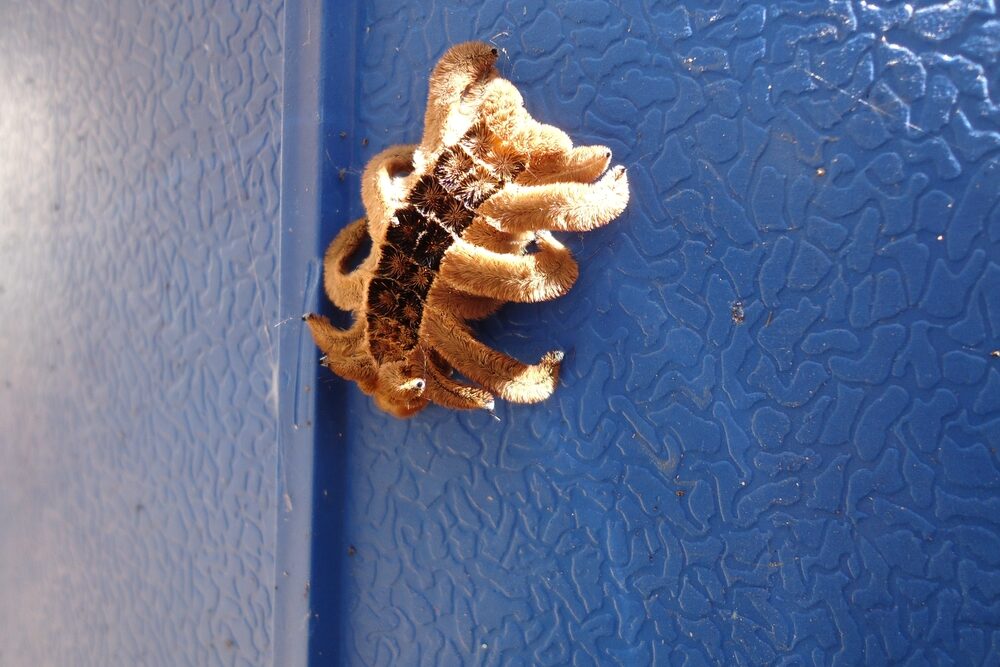1. The Fluffy Horror Show: The Puss Caterpillar (Megalopyge opercularis)

It looks like a tiny, walking toupee. Or maybe a lint ball with legs. But don’t be fooled—this soft-looking nightmare, also known as the puss caterpillar, is one of the most venomous caterpillars in North America. Beneath its innocent, silky fur lies a network of venomous spines capable of delivering excruciating pain. Victims describe the sting as feeling like molten metal searing into their skin, followed by waves of nausea, headaches, and even difficulty breathing.
And it doesn’t stop there. The venom can cause hours (or even days) of agony, radiating pain throughout the body and sometimes leading to hospital visits. These deceptively adorable creatures lurk in oak and elm trees, blending in like harmless little fuzzballs—until an unsuspecting hand brushes against them. Some people have even reported the pain traveling to their bones, proving that, sometimes, the cutest creatures are the deadliest.
2. The Killer Pinecone: The Giant Silkworm Moth Caterpillar (Lonomia obliqua)

Imagine a caterpillar so venomous that simply brushing against it could trigger internal bleeding. Meet Lonomia obliqua, the master of disguise and silent assassin of the insect world. Looking like a harmless pinecone or a bit of bark, this Brazilian nightmare doesn’t just sting—it attacks your blood.
Its venom contains powerful anticoagulants that can cause a condition called disseminated intravascular coagulation (DIC), where your blood stops clotting properly. Victims experience spontaneous bruising, internal hemorrhaging, and in severe cases, multi-organ failure. Some unlucky individuals have bled to death from caterpillar contact. And just in case you thought you could spot one and avoid it, think again—these killers tend to hang out in groups, turning tree trunks into death traps for the unwary.
3. The Toxic Tuft: The Saddleback Caterpillar (Acharia stimulea)

With its bright green “saddle” and punk-rock spikes, Acharia stimulea looks like something straight out of a sci-fi movie. But this tiny, spiky powerhouse is not just about aesthetics—it’s a biological landmine. Those vibrant bristles? Loaded with venom that delivers an electric shock of pain, followed by swelling, dizziness, nausea, and in severe cases, anaphylactic shock.
What makes it even worse? The spines embed themselves in your skin, releasing toxins for hours like microscopic needles of doom. Even after the pain subsides, the affected area can stay irritated for days. Found across the eastern United States, these caterpillars love hanging out on garden plants, making them a painful surprise for unsuspecting gardeners. If you ever see one, admire it from a very safe distance.
4. The “Friendly” Fire Starter: The Flannel Moth Caterpillar (Megalopyge crispata)

This caterpillar could easily be mistaken for a plush toy. It’s fluffy, harmless-looking, and even called a flannel moth caterpillar. But touching it is like setting your skin on fire. Packed under its deceivingly soft exterior are venomous spines that trigger an intense burning sensation, followed by swelling, blisters, and sometimes full-body reactions like fever and vomiting.
The worst part? The pain spreads outward, radiating in waves and making it feel like your entire nervous system is under attack. These living booby traps are common in the southern United States, particularly in Texas and Florida, where they nonchalantly lounge on trees, waiting for an unfortunate brush of skin. And just when you think the worst is over, some people report lingering pain for up to a week.
5. The Brazilian Bloodletter: The Taturana Caterpillar (Lonomia sp.)

Not to be outdone by its cousin Lonomia obliqua, the Taturana caterpillar brings another level of horror to the mix. Native to South America, this caterpillar’s venom can cause a fatal condition known as hemorrhagic syndrome, where the victim’s blood turns against them—literally.
After an accidental brush with one, people experience dizziness, headaches, and massive internal bleeding, sometimes leading to organ failure. In severe cases, death can occur within 24 hours. And here’s the kicker: they love to cluster together, meaning one misstep can expose you to dozens of venomous spines at once. Researchers have even nicknamed them the “silent executioners” of the jungle.
6. The Nettle Nightmare: The Stinging Rose Caterpillar (Parasa indetermina)

Looking like a tiny psychedelic masterpiece, Parasa indetermina is one of the most beautifully bizarre caterpillars you’ll ever see. Its body is covered in neon-colored spines that seem almost ornamental. But if you touch it? Congratulations—you’ve just signed up for an intense burning sensation, swelling, and pain that spreads like wildfire.
Unlike other venomous caterpillars, this little menace doesn’t just rely on spines—it has multiple toxin-loaded barbs that can pierce the skin from any angle. Victims have reported numbness, muscle pain, and in some cases, severe allergic reactions. And because it’s found across North America, you might accidentally meet one while gardening or hiking. The lesson? Never trust a caterpillar that looks like it was designed by a graffiti artist.
7. The Hellspawn Hairbrush: The Monkey Slug Caterpillar (Phobetron pithecium)

If someone designed a caterpillar based on nightmare fuel, this would be it. The monkey slug caterpillar looks like a hairy, dismembered tarantula. But instead of just scaring you, it has another trick up its sleeve—venomous spines hidden beneath its bristly horror-show body.
A simple touch can result in painful skin irritation, itching, and burning. While its venom isn’t as lethal as some others on this list, the sheer creep factor of this creature is enough to give anyone chills. Found in the eastern U.S., these caterpillars cling to tree bark, waiting for an unsuspecting passerby to make the mistake of touching what looks like a piece of hairy debris. Spoiler alert: it’s not debris. It’s a tiny terror in disguise.
8. The Silent Assassin: The Bag Shelter Caterpillar (Ochrogaster lunifer)

Commonly found in Australia, Ochrogaster lunifer may not look like much at first. But these fuzzy little caterpillars come with a horrifying defense mechanism: their hairs contain a protein that causes severe allergic reactions, skin irritation, and even blindness. And they don’t just sit there waiting to be touched—these caterpillars travel in long processions, marching like a tiny, coordinated army of misery. If disturbed, they release their poisonous hairs into the air, meaning you don’t even have to touch them to feel their wrath. Victims have reported blistering skin, severe eye irritation, and in rare cases, respiratory distress from inhaling the airborne venom.
Some Australian farmers call them “walking nightmares” because they seem to appear out of nowhere, covering entire trees or pathways with their slow-moving but deadly procession. If there was ever a caterpillar that embodied, look but don’t touch, this would be it. They might look like living cotton balls, pinecones, or tiny works of art, but these caterpillars pack a venomous punch. Some can send you to the hospital with agonizing pain, while others might just stop your blood from clotting altogether. So next time you see an innocent-looking caterpillar crawling on a tree, think twice before reaching out—it might just be a tiny, fuzzy assassin in disguise.


